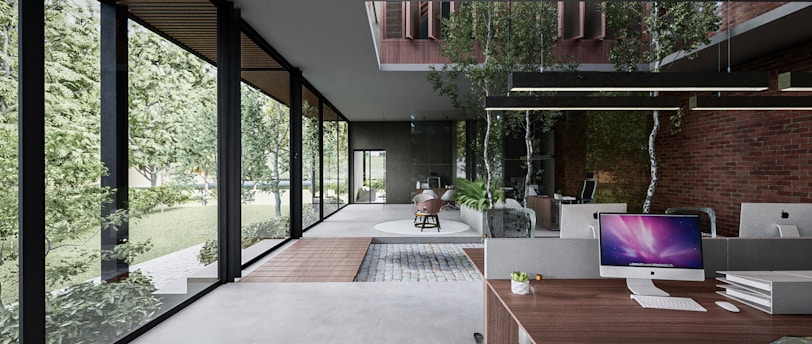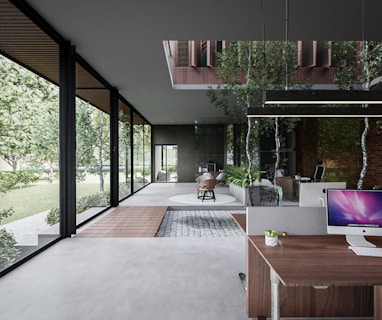Biophilic Design: How to Bring Nature Indoors for Better Health and Productivity
Biophilic design is a concept that uses elements of nature to create healthier and more productive environments. This blog post will discuss the benefits of biophilic design in detail and provide some tips on how to implement it in your own home or workplace.
8/9/20235 min read


Introduction
Biophilic design is a concept that has been gaining popularity in recent years. It is based on the idea that humans have a natural connection to nature and that exposure to natural elements can have a positive impact on our health and well-being.
The word "biophilia" comes from the Greek words "bios" (life) and "philia" (love). It was coined by the biologist Edward O. Wilson in his 1984 book, Biophilia: The Human Bond with Nature. Wilson argued that humans have an innate need to connect with nature and that this connection is essential for our physical and mental health.
There is a growing body of research that supports the benefits of biophilic design. For example, one study found that people who worked in offices with plants had lower blood pressure and heart rates than those who worked in offices without plants. Another study found that students who attended schools with biophilic design elements had improved cognitive function and academic performance.
Benefits of Biophilic Design
The benefits of biophilic design are many and varied. Here are some of the most well-studied benefits:
Improved physical health: Exposure to nature has been shown to reduce stress, improve heart health, and boost the immune system. For example, one study found that people who lived in homes with views of nature had a 20% lower risk of death from heart disease than those who did not have views of nature.
Enhanced mental health: Biophilic design can improve mood, reduce anxiety, and increase creativity. For example, one study found that people who worked in offices with plants had lower levels of stress and anxiety than those who worked in offices without plants.
Increased productivity: Studies have shown that people who work in biophilic environments are more productive and have fewer sick days. For example, one study found that call center workers who had views of nature took 12% fewer sick days than those who did not have views of nature.
Improved sleep quality: Exposure to natural light can help regulate the body's natural sleep-wake cycle. For example, one study found that people who slept in rooms with natural light had better sleep quality than those who slept in rooms without natural light.
Reduced stress levels: Studies have shown that people who have access to nature have lower stress levels than those who do not. For example, one study found that people who lived in areas with more green space had lower levels of stress and anxiety than those who lived in areas with less green space.
How to Implement Biophilic Design
There are many ways to implement biophilic design in your home or workplace. Here are a few tips:
Bring in plants: Plants are one of the most important elements of biophilic design. They can help to improve air quality, reduce noise pollution, and create a sense of calm and relaxation. When choosing plants for your home or workplace, opt for plants that are native to your area. This will help to ensure that they are well-suited to your climate and that they will thrive in your environment.
Use natural materials: Natural materials, such as wood, stone, and brick, can help to connect us with nature. When choosing furniture and other materials for your home or workplace, opt for natural materials that have a calming and relaxing effect.
Add natural light: Natural light is essential for good health and well-being. If possible, try to design your space so that it receives plenty of natural light. If you can't get enough natural light from windows, consider adding skylights or other light fixtures that mimic natural light.
Create views of nature: Even if you can't bring nature inside, you can still create a connection to it by providing views of natural landscapes. If you have a window, frame it with plants or flowers to create a more natural-looking view. You can also hang pictures or paintings of nature scenes to bring the outdoors in.
Use water features: Water features can help to create a sense of peace and tranquillity. If you have the space, consider adding a small fountain or pond to your home or workplace. You can also use water features in a more subtle way, such as by adding a water feature to your wallpaper or drapes.
Use soundscapes: Soundscapes, such as the sound of running water or birdsong, can help to bring nature indoors. You can create your own soundscape by playing recordings of nature sounds, or you can purchase pre-made soundscapes online.
Consider the layout of your space: The layout of your space can also play a role in biophilic design. If possible, try to arrange your furniture so that you have a view of nature. You can also use natural light to create different zones in your space. For example, you could create a reading nook in a corner where the sunlight streams in.
Get creative: There are many ways to implement biophilic design in your home or workplace. Don't be afraid to get creative and experiment with different ideas. The most important thing is to create a space that you feel comfortable and relaxed in.
Green Goods Guide
In addition to the tips mentioned above, here are some green goods that you can use to create a biophilic environment in your home or workplace:
Air purifier: An air purifier can help to remove pollutants from the air and improve air quality. Look for an air purifier that is certified by the Association of Home Appliance Manufacturers (AHAM) and has a high CADR (Clean Air Delivery Rate) rating.
Plants: There are many different plants that have air-purifying properties. Some popular choices include spider plants, peace lilies, and English ivy. When choosing plants for your home or workplace, opt for plants that are native to your area. This will help to ensure that they are well-suited to your climate and that they will thrive in your environment.
Natural materials: When choosing furniture and other materials for your home or workplace, opt for natural materials, such as wood, stone, and brick. These materials can help to create a sense of warmth and cosiness in your space.
Natural light: If possible, try to design your space so that it receives plenty of natural light. Natural light has been shown to have a positive impact on our mood and productivity.
Views of nature: Even if you can't bring nature inside, you can still create a connection to it by providing views of natural landscapes. If you have a window, frame it with plants or flowers to create a more natural-looking view. You can also hang pictures or paintings of nature scenes to bring the outdoors in.
Water features: Water features can help to create a sense of peace and tranquillity. If you have the space, consider adding a small fountain or pond to your home or workplace. You can also use water features in a more subtle way, such as by adding a water feature to your wallpaper or drapes.
Soundscapes: Soundscapes, such as the sound of running water or birdsong, can help to bring nature indoors. You can create your own soundscape by playing recordings of nature sounds, or you can purchase pre-made soundscapes online.
Conclusion
Biophilic design is a powerful tool that can be used to create healthier and more productive environments. By incorporating elements of nature into our homes and workplaces, we can improve our physical and mental health, boost our productivity, and reduce stress levels.
We hope this blog post has helped you learn more about biophilic design and how to implement it in your own home or workplace. Together, we can create healthier and more sustainable environments for ourselves and future generations.
Keywords
biophilic design
nature in the workplace
health benefits of biophilic design
productivity benefits of biophilic design
green goods for biophilic design
biophilic design trends
biophilic design case studies
biophilic design research
how to implement biophilic design
biophilic design tips
biophilic design for beginners
